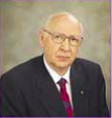Leif Hallberg, 1999 awardee
Prof. Leif HALLBERG, 1999 awardee
 Prof. Hallberg was born in Lund, Sweden, in 1923. He graduated from the University of Lund medical school in 1948 and obtained his Ph. D. in 1955 from the University of Göteborg. From 1967 to 1989, Prof. Hallberg served as Head of the Department of Medicine and Chief Physician of the Department of Internal Medicine at the University of Göteborg, while being Director of the Sahlgrenska University Hospital in Göteborg, from 1969 to 1975.
Prof. Hallberg was born in Lund, Sweden, in 1923. He graduated from the University of Lund medical school in 1948 and obtained his Ph. D. in 1955 from the University of Göteborg. From 1967 to 1989, Prof. Hallberg served as Head of the Department of Medicine and Chief Physician of the Department of Internal Medicine at the University of Göteborg, while being Director of the Sahlgrenska University Hospital in Göteborg, from 1969 to 1975.
In 1970, he participated in the establishment of the International Nutritional Anemia Consultative Group. His expertise on nutritional anemias and iron nutrition has been sought after worldwide. As an active member of several Swedish and European medical associations, Prof. Hallberg also contributed as an advisor and expert to international agencies such as WHO, IAEA, FAO and UNICEF. He participated to the Joint FAO/WHO Expert Consultation on Human Vitamin and Mineral Requirements, in 1998.
Throughout his career, Prof. Hallberg’s prolific research have led to the publication of over 400 papers, namely in internal medicine, hematology and nutrition. Two of his papers presenting his work on iron requirements in women were nominated as “Citation Classics”.
Research Work
Prof. Hallberg’s early research work focused on the use of iron radioisotopes in the hematology field. His development of breakthrough methods in this area opened new possibilities in the study of iron kinetics and absorption and provided solid groundwork for future research. The techniques using iron labeling allowed Prof. Hallberg and his team to extensively study the regulation of absorption of both heme and non-heme iron as well as total iron absorption from different types of meals and diets. Factors influencing iron absorption were identified, which included meat, fish, fiber, ascorbic acid, phytate and calcium. The important finding of an effective down-regulation mechanism for dietary iron absorption with increasing iron stores supported the use of iron fortified foods since dietary iron overload was found to be naturally prevented in healthy subjects. Prof. Hallberg’s work with radiolabeled iron made possible the study of iron bioavailability in different compounds used for iron fortification and to develop a new iron compound for flour fortification.
Prof. Hallberg devoted much of his research to the study of different hematological measurements in the diagnosis of iron deficiency. He found that most classical laboratory tests parameters show a marked overlap in the distributions of iron deficient and iron replete subjects, thus underestimating the true prevalence of iron deficiency. In 1972, the introduction by Addison, Jacobs et al. of serum ferritin for the evaluation of iron status constituted a marked diagnostic improvement. To maximize the use of this tool, Prof. Hallberg participated in the development of the international serum ferritin standard, proposed in 1985. Studies followed to identify an optimal serum ferritin cut-off value to best discriminate between iron deficient and iron replete subjects. Confounding factors that raise serum ferritin levels were also identified. Recently, Prof. Hallberg developed equations to translate serum ferritin into iron stores and evaluate iron kinetics under different conditions. These results contributed important knowledge to the understanding of iron balance.
Prof. Hallberg’s longlife study of iron status in women begun in 1964 with the development of new chemical methodology to determine menstrual blood loss, enabling, for the first time, the magnitude of individual menstrual iron losses to be assessed. It was found that blood losses in women are genetically determined and are very constant within individuals, but vary markedly between women. It thus became possible to determine individual iron requirements in women and the distribution of their requirements.
Prof. Hallberg’s findings showed that losses of iron and their distributions in relation to body size are the same all over the world, suggesting that the relative iron losses are similar across most populations and have probably differed little for hundreds of thousands of years. Further research established that variations in iron status in women between populations were mainly due to differences in dietary intake rather than to differences in requirements.
In parallel, several investigations were conducted on iron balance in pregnancy. It was found that iron absorption is reduced during the first trimester of pregnancy, due to the fact that requirements are much lower in absence of menses, and that iron absorption is increased only in the middle of the second trimester. However, Prof. Hallberg’s studies showed that this increased absorption, independently of the quality of the diet, is not sufficient to cover the increased iron requirements in pregnancy. Considering that iron deficiency is the most common deficiency worldwide, reaching a healthy iron status in women remains a great public health challenge to which Prof. Hallberg is committed through his active contribution to the establishment of national and international policies on iron nutrition.
